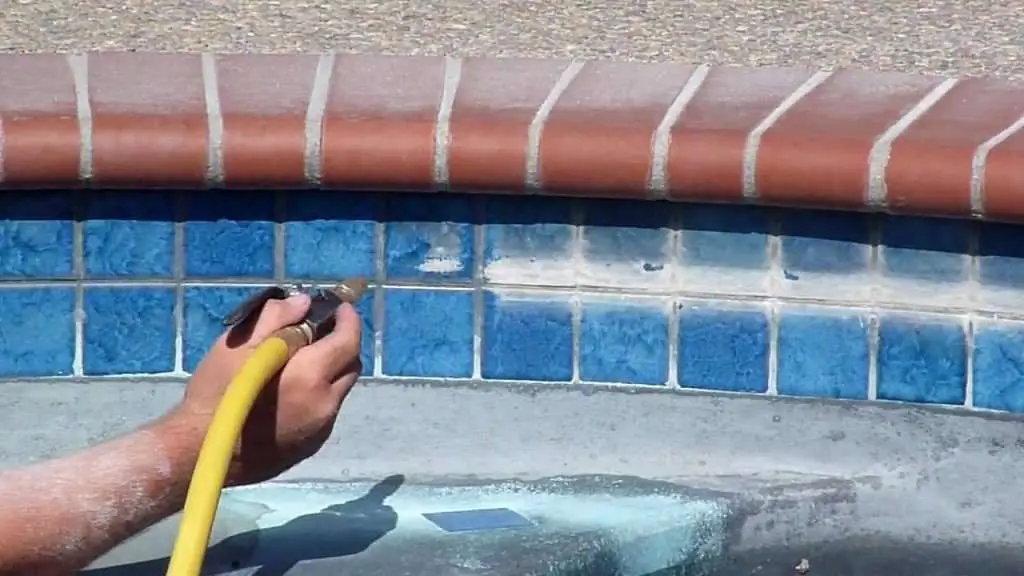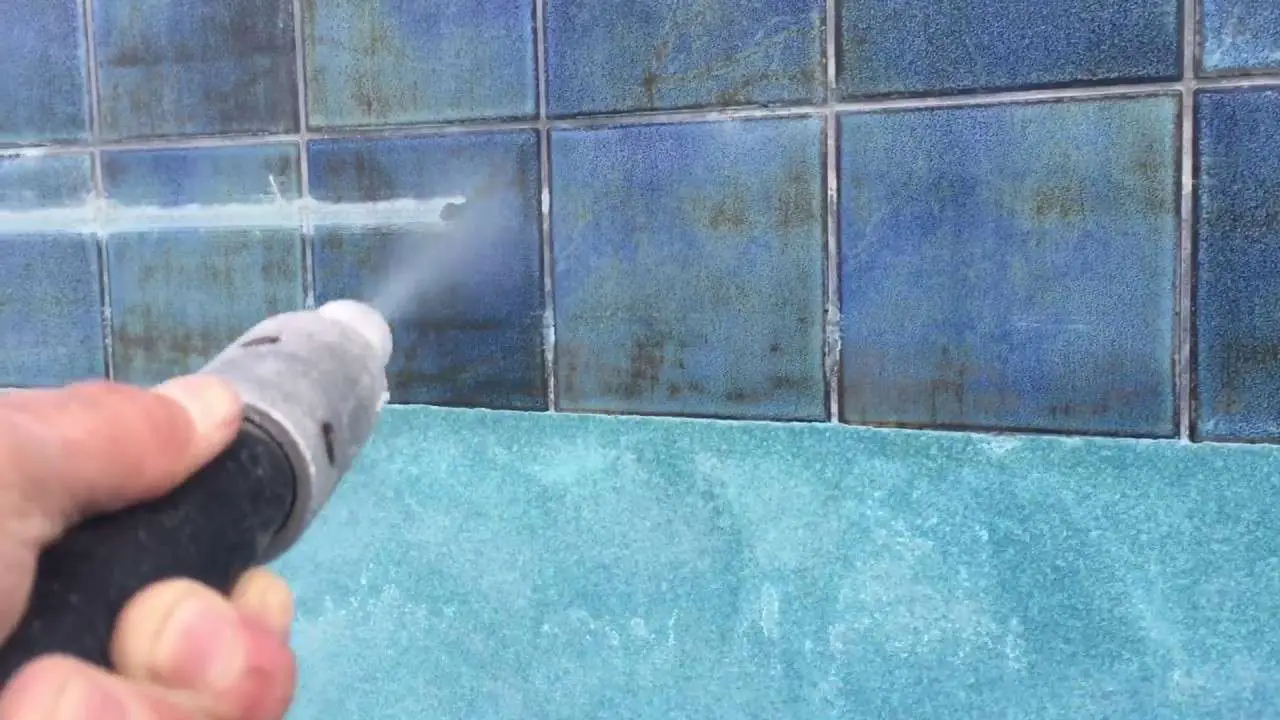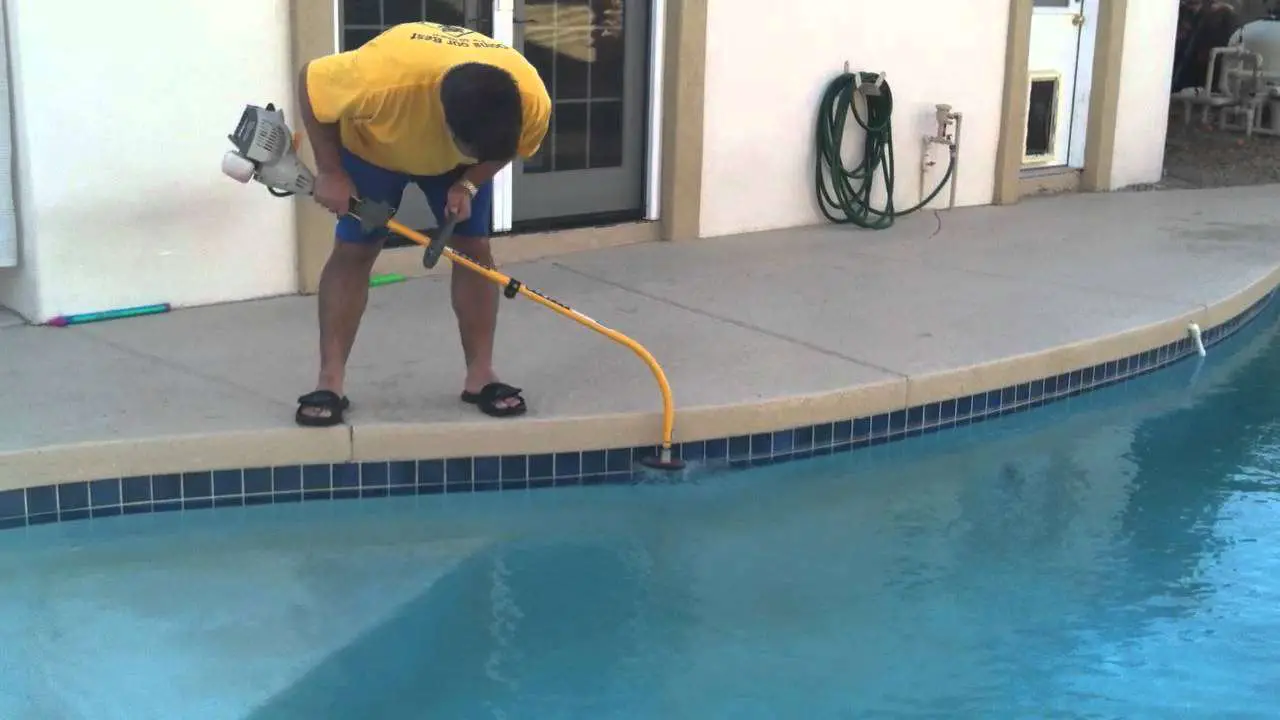How To Remove Pool Stains From Algae:
Keep in mind that if a green discoloration brushes off or dissipates with a shock treatment, you dont have stains you have algae. Kill algae growth with the appropriate treatment shock and algaecide. Check circulation and filtration systems to ensure theyre functioning properly. Be certain to add the correct amount of sanitizer, routine shock and preventative algaecide for your pools needs, test and balance your water weekly, regularly remove debris and brush.
Green Or Green/brown Stains
Leaves, grass clippings, and other organic plant materials in the water often cause these types of stains. Keep up with regular pool cleaning to prevent excess plant debris from settling to the bottom of the pool. Use a pool rake/leaf skimmer, automatic pool cleaner, and/or a leaf vacuum to remove the debris.
How To Prevent Calcium Scale
Most calcium scale is caused by water chemistry interactions that can be avoided or circumvented by using several of these calcium scale prevention methods.
- Use a sequestering agent to keep calcium locked up in solution, so it cant precipitate into scaly deposits. Chemicals such as Stain Away or Scale Free sequester metals and minerals. But, only if you apply the regular maintenance doses every week or two.
- Avoid calcium hypochlorite shock, which adds calcium to the pool. Use a non-chlorine oxidizer, or di-chlor pool shock.
- Lower your pH and Alkalinity on the low end of the scale a pH of 7.2-7.4 and Alkalinity of 80-90 ppm. High pH and Alkalinity create ideal scaling conditions.
- Compute your LSI, a formula that computes your waters propensity to scale. Negative results below 0.0 are best to avoid scaling. Pentair LSI calculator does the math for you.
- Use a clarifierto seek out calcium particles and clump them together so that your pool filter can remove.
- Brush your pool often to remove newly formed scale, and vacuum or run the pool cleaner several times per week to remove calcium dust and dirt.
Also Check: How To Warm Water In Above Ground Pool
Types Of Pool Cleaning Brushes For Tile
You should choose a pool cleaning brush designed for your type of swimming pool. For instance, if the tile is in a plaster pool, you can use a pumice stone or a hard bristled brush. However, for a fiberglass pool, accidentally brushing the liner with a hard brush can cause damage. For this reason, it is best to use a textured, soft sponge on your water line tile in fiberglass pools.
How To Remove Calcium Scaling And Lower Calcium Hardness

Calcium scaling isnt fun for anyone. It dirties your pool walls with unappealing, chalk-white deposits along the water line. The same type of scaling that affects your pool equipment and plumbing as well, accelerating wear and tear. You know its because of your calcium hardness levels, but keeping them controlled is tough. Plus, you still need to figure out how to remove calcium scaling and buildup.
Fortunately, thats what this blog post is all about.
Don’t Miss: Venetian Garden Pool
Eye And Skin Irritation
If people do continue to swim in a pool with the excess calcium that is causing the deposits, there is a strong chance that it will cause irritation to their skin and eyes.
The long and short of it is that calcium deposits and scaling look unappealing, make pools uncomfortable to swim in and can cause serious and expensive damage long term.
Knowing all that, why wouldnt you try to remove calcium buildup as quickly as possible?
Now, lets consider how to remove calcium from pool tile. Some materials and tactics which have proven to be effective include:
- Baking soda
- Vinegar
- Power washing
Lets focus on one of the most popular how to clean pool tile with vinegar as well as a few other options, depending on how much calcium buildup there is to remove.
Why Calcium Is A Problem
Two types of calcium can cause problems with pools. Sometimes deposits consist of a fine film that builds up in layers, leaving behind a residue that easily comes off tiles if theyre cleaned regularly. This is called calcium carbonate. Sometimes buildup results in sharp, crystalized and sandy particles that attach to the tiles, caused by high calcium and pH levels in the water, and which requires more intensive cleaning methods. This is calcium silicate.
Learning how to remove calcium from pool tiles early can save both time and money. Often referred to as calcium scale, it gets worse the longer its left. Ignoring it will cause damage not only to pools, but to pool equipment as well. Regularly cleaning any scum lines usually presenting as white or light gray deposits will keep the buildup at bay and make pool tile scale removal easier. Sometimes it just involves cleaning the deposits with a soft cloth. Since this is easier done when in the pool, its a chore that can keep the cleaner cool on a hot day.
Don’t Miss: Aria Las Vegas Swimming Pool
Use The Appropriater Pool Scale Remover
Once testing and adjusting the calcium, pH and alkalinity the final step is to clean out the scale. Following are some of the tools and cleaning solutions you need.
Muriatic Acid
Muriatic acid is one of the most effective scale removers. Our recommendation is Acid Magic
It is full strength 1-to-1 replacement for muriatic acid. This product has all the cleaning, etching, and PH reduction properties of powerful acids but with 90 percent less fumes it will not cause burns to intact skin.
Acid Magic is one of the best products for dissolving calcium deposits on filter cartridges, and for cleaning tile and concrete
Pool Metal Out
Pool Mates Metal Out pool product helps prevent discoloration of pool water due to iron, calcium, manganese, copper and other metals and minerals which may be present in the water supply
It is an excellent general-purpose sequestrant that helps protect plumbing and pool walls from rust, stain and scale
Descaler and Stain Remover
One of the most popular descaler and stain remover is the EasyCare Scaletec Plus Descaler. This product removes calcium buildup and other stains without scrubbing, acids, or pool draining
Pool Scrub Brush
This is a heavy-duty 18 swimming pool scrub brush for cleaning pool walls, tiles & floors. It is made up of Aluminum and stainless-steel wire bristle.
You can use this scrub brush with vinegar, muriatic acid or pool Clorox bleach
Pool Pumice Stone
Removing Calcium Silicate Scaling
The only reliable way to remove calcium silicate deposits is with a pumice stone and a lot of hard work. These stains are notoriously difficult to scrub free.
If you have a vinyl or fiberglass pool, you wont be able to use a pumice stone. It would scratch the pool. A calcium-scaling specific additive may remove the deposits, but these products can take months to dissolve calcium silicate. If you cant use a pumice stone, you ought to contact a pool service provider in your area to use professional products that can quickly remove the deposits.
Read Also: How Much Does An Inground Pool Cost In Mississippi
Option 1 Calcium Removal Diy Kit
FREE DELIVERY
- 1 Litre of our powerful calcium release and prevention formula
- 4 Kgs of our granular calcium dissolving compounds custom made for your stain
- Phone support from our technicians
- Simple step-by-step instructions included
- Pool does NOT need to be drained
- Kit is sent and electronically tracked by Aramex Couriers
- Kids are back in the pool in just 7 days
- Kit is $295 for pools 40,000+ Litres
Removal Of Calcium Carbonate
Before you can start the removal process, make sure to get the pH level in the pool correct. There is no sense in working hard to get this fixed if the conditions for keeping it away are not ideal.
The first step is to use a calcium descaling spray to help loosen up the area that you are going to work on. Unfortunately, just spraying the area is not going to fix the problem you are going to need a little elbow grease.
If you have a concrete pool or the calcium buildup is on the tile, the best way to scrub it is with a pumice stone. If you have a vinyl pool, a pumice stone is not going to work. When working with the pumice stone, you will find the best results keeping the area wet the entire time you are working. When it dries out, you could see some scratching, and you dont want to leave yourself with damage after the calcium is gone.
If you have a vinyl pool or are looking to do a little less scrubbing, there is a treatment you can use it will just take longer to see the results. A descaler removal gel is a great way to get those tricky spots that cannot be addressed by scrubbing. This type of gel will stick to the surface and work to break down the calcium and other stains. A descaling gel like this one works on lime, water stains, and other buildup in addition to calcium.
Read Also: Mandalay Bay Pool Hours Summer
How To Remove Calcium Scaling From A Swimming Pool
Keeping a swimming pool clean takes a lot of effort. But as a responsible pool owner, you take all the right steps. You balance your pool water, you brush, and you vacuum. For the most part, your pool stays clean. But you start to notice an unpleasant white scale on the side of your pool. Maybe youre noticing little white bumps forming on the walls, railings, and ladders. Or perhaps youve started to get the dreaded pool toe. The culprit is calcium scaling. Calcium is building up on the walls and other surfaces of your pool, and its not going away. If youve found yourself in a battle with calcium scaling, you know that its not easy to beat. But it can be done. So here is our guide to removing calcium scaling from your swimming pool.
Types Of Calcium Scaling In A Swimming Pool

There are two types of calcium scaling, and one is much harder to beat than the other. Your typical, run of the mill scaling is calcium carbonate. Calcium carbonate can be a pain, but you can defeat it. The other type of calcium scaling is calcium silicate. Calcium silicate forms much more slowly, but once its there, its nearly impossible to remove yourself. Even worse, if you have calcium silicate, there is a very good chance that you also have buildup in your pipes. A calcium silicate buildup requires professional intervention.
You can tell the difference between a calcium carbonate and calcium silicate buildup by putting a drop of muriatic acid on the calcium scaling. If the calcium scaling starts to react with the acid and foam, you have calcium carbonate. If nothing happens, youve got calcium silicate. If thats the case, contact The Pool Butler for a full professional cleaning. Its important not to let a calcium silicate build up for too long, as it will eventually damage your pipes and your filter.
Recommended Reading: Aria Cabana Prices
Removing Scaling From Fiberglass Pool
To remove minor scaling and other metal stains, rub a vitamin C tablet directly on the affected areas to release the stains from the pool surface.
Add an appropriate amount of sequestering agent to bring together the released metal stains.
Form major metal staining, use ascorbic acid and a sequestering agent.
You can also use a stain eraser to remove calcium carbonate scaling from a fiberglass pool.
For tougher stains and scaling that you cannot handle seek help from your local pool care professionals.
How To Remove Calcium Scale From A Pool
- |December 5, 2020
Having your own pool can not only make your backyard more fun, but also add a touch of class.
But if a regular maintenance schedule isnt adhered to, your luxurious oasis can begin to look run-down, with calcium scale buildup being a common problem.
In order to restore the pool to its former glory, youll have to learn the proper pool calcium removal techniques.
Skip to:
You May Like: How To Repair Cracks In Concrete Pool Deck
Calcium Added To Pool Surface Batch During The Application Process
In most cases, swimming pool surface applicators will add calcium chloride to the interior mix to accelerate the curing process. Adding calcium will cause the cement pool render to dry faster. Also, adding calcium to the mix is also done to prevent the wet surface from slumping or sliding down the walls during application. Most importantly, adding calcium also helps the contractors can get to the next job faster!
We have found that some pool surfaces that have been applied on rainy days or during very cool weather often have more calcium chloride added to the mix to assist in the drying process. We are not suggesting that adding calcium is a bad thing, but certainly, an excess of calcium can be unhelpful and can lead to bleed water entrapment. Also, by speeding up the curing process too much, the concrete is not able to reach its optimum strength. Should this occur then discolouration of the pool surface may become evident in the future. This type of staining can be very difficult to remove.
How To Clean Pool Tile And Remove Calcium
Many in-ground pools feature beautiful, multi-colored ceramic or glass tiles that look great if kept clean and well-maintained. But if the tiles arent maintained, they can become stained or covered in buildup. Fortunately, you can take some quick, easy steps to clean the tile and bring it back to its original luster.
But before we talk about how to clean that tile, lets get some basics out of the way.
Also Check: How To Build An Infinity Pool
Understanding Why And How To Remove Calcium Deposits
Howand whydoes a pool develop calcium deposits?
There are a few reasons you may start to notice these stains around your waterline.
The first is hard water, which can leave behind a calcium residue over time. If you live in a part of the country with hard water, youve probably already noticed this buildup on your faucets, sinks and maybe even tubs.
The second culprit is heat, which the southern half of the U.S. has in abundance. Not only do high summer temperatures cause pool water to evaporate more, but also they raise the temperature of the water itself.
When combined with the third culpritthe chemical makeup of your poolthese conditions can lead to calcium deposits. Specifically, if your pool has high pH, high alkalinity and warmer water, calcium scale will begin to form.
The reason this situation so often happens at the water line is because of evaporation.
These crystals of calcium may appear as nodules that dot metal and plaster, or they might become crusty deposits that live in the corners of your pool.
Technically, these are two distinct things. Calcium carbonate, which tends to manifest as a flaky substance on the surface of the pool, and calcium silicate, which is grayish white and harder.
Either way, theyre not exactly aesthetically pleasing.
But thats not the worst part. To protect your pool, you need to remove calcium buildup altogether.
Hire A Professional Bead Blaster
If removing the pool scale doesn’t work with the methods we’ve already listed, you probably have a severe case of pool scaling that needs professional attention.
You can hire a professional pool company to come to your pool to remove the calcium. This process is called bead blasting and is sometimes called pressure washing.
This service is different than how you would use a pressure washer to wash your car. Professional companies use a compressor to blast sand, beads or other materials at the pool tile at high speed.
This scrapes away the buildup quickly. And you don’t have to spend time scrubbing the tile yourself.
Most companies use magnesium sulfate to blast the calcium off your pool tiles.
Note, this option can be very expensive. Ideally, you want to remove calcium buildup on your own. And practice good pool maintenance to prevent pool scaling in the future.
You May Like: When Does Tibbetts Pool Open
Contact The Pool And Spa Professionals At Halogen Supply
If you need advice or help when looking into how to remove calcium from pool tiles, contact us at Halogen Supply today to speak with our support staff. As experts with an average of over 20 years experience in all things swimming pools, they can answer any of questions you might have about swimming pools or spas and their upkeep.
Removing Calcium Scale From Tile

Tile can be a bit tricky for calcium scale removal, as its a bit more delicate to work with.
Some people recommend scraping them with a putty knife or razor blade. Some will even use a hammer to chip away at the scale.
While these techniques do work, the possibility of damaging your expensive pool tiles using these methods is extremely high.
Its for this reason we recommend using a stain remover brush and chemical agent combination for pool tiles.
Also Check: How Much Chlorine To Add To Pool Calculator
Why Is Calcium Scale A Problem
Aside from being an eyesore that detracts from the beauty of your pool, calcium buildup and scaling can lead to long-term damage.
As mentioned, the pH level of the pool has to stay balanced to keep calcium levels from spiking and scale from forming. When the water is too saturated with calcium, it causes calcium deposits that appear as nasty pool stains and cloudy water.
On the flipside, low calcium levels will lead to water actually corroding your pools finish. Etching will result if you have a plaster finish, and the water will literally eat through fiberglass or vinyl liner as it searches for calcium to balance itself.
